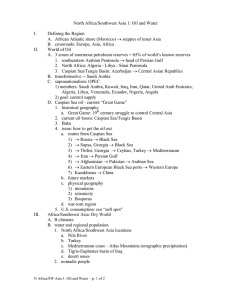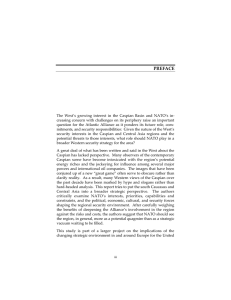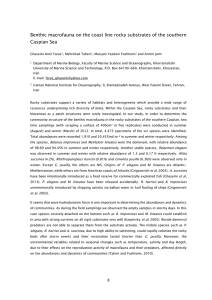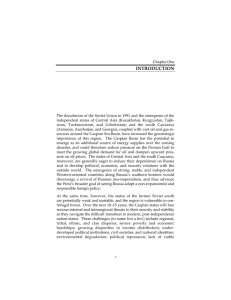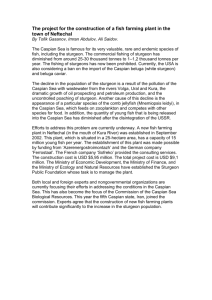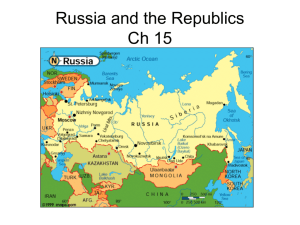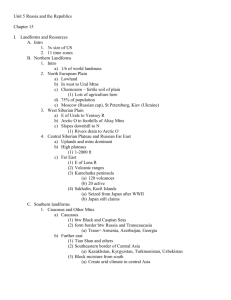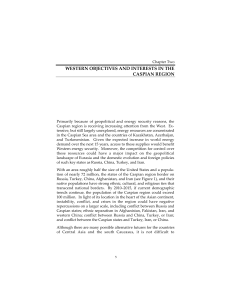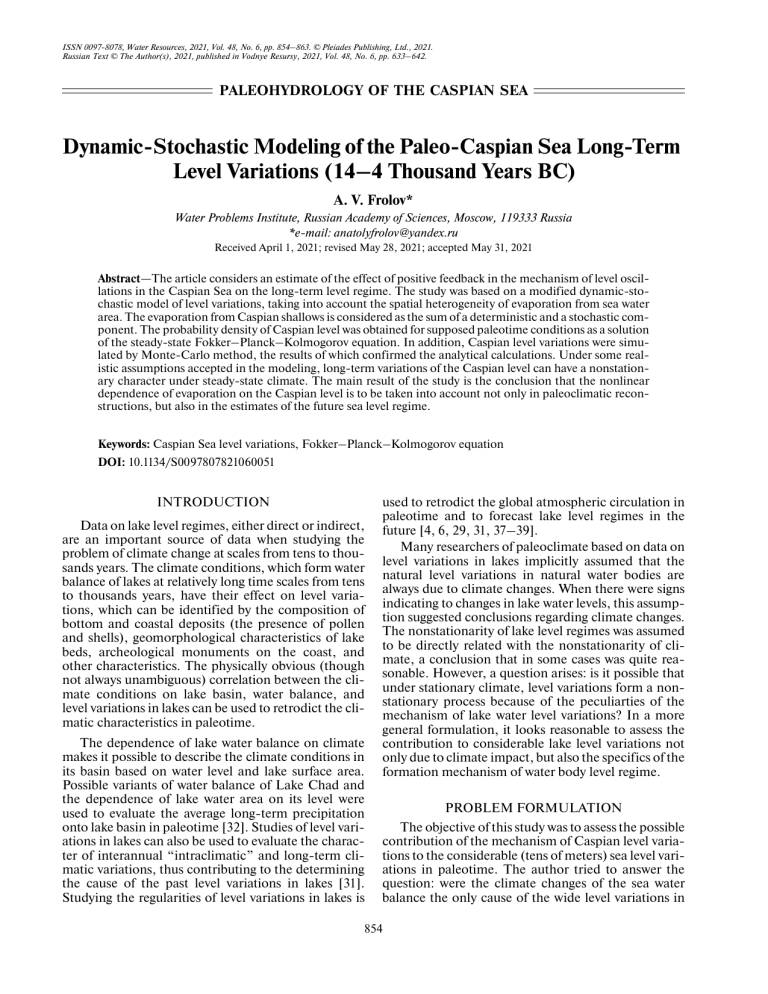
ISSN 0097-8078, Water Resources, 2021, Vol. 48, No. 6, pp. 854–863. © Pleiades Publishing, Ltd., 2021. Russian Text © The Author(s), 2021, published in Vodnye Resursy, 2021, Vol. 48, No. 6, pp. 633–642. PALEOHYDROLOGY OF THE CASPIAN SEA Dynamic-Stochastic Modeling of the Paleo-Caspian Sea Long-Term Level Variations (14–4 Thousand Years BC) A. V. Frolov* Water Problems Institute, Russian Academy of Sciences, Moscow, 119333 Russia *e-mail: anatolyfrolov@yandex.ru Received April 1, 2021; revised May 28, 2021; accepted May 31, 2021 Abstract—The article considers an estimate of the effect of positive feedback in the mechanism of level oscillations in the Caspian Sea on the long-term level regime. The study was based on a modified dynamic-stochastic model of level variations, taking into account the spatial heterogeneity of evaporation from sea water area. The evaporation from Caspian shallows is considered as the sum of a deterministic and a stochastic component. The probability density of Caspian level was obtained for supposed paleotime conditions as a solution of the steady-state Fokker–Planck–Kolmogorov equation. In addition, Caspian level variations were simulated by Monte-Carlo method, the results of which confirmed the analytical calculations. Under some realistic assumptions accepted in the modeling, long-term variations of the Caspian level can have a nonstationary character under steady-state climate. The main result of the study is the conclusion that the nonlinear dependence of evaporation on the Caspian level is to be taken into account not only in paleoclimatic reconstructions, but also in the estimates of the future sea level regime. Keywords: Caspian Sea level variations, Fokker–Planck–Kolmogorov equation DOI: 10.1134/S0097807821060051 INTRODUCTION Data on lake level regimes, either direct or indirect, are an important source of data when studying the problem of climate change at scales from tens to thousands years. The climate conditions, which form water balance of lakes at relatively long time scales from tens to thousands years, have their effect on level variations, which can be identified by the composition of bottom and coastal deposits (the presence of pollen and shells), geomorphological characteristics of lake beds, archeological monuments on the coast, and other characteristics. The physically obvious (though not always unambiguous) correlation between the climate conditions on lake basin, water balance, and level variations in lakes can be used to retrodict the climatic characteristics in paleotime. The dependence of lake water balance on climate makes it possible to describe the climate conditions in its basin based on water level and lake surface area. Possible variants of water balance of Lake Chad and the dependence of lake water area on its level were used to evaluate the average long-term precipitation onto lake basin in paleotime [32]. Studies of level variations in lakes can also be used to evaluate the character of interannual “intraclimatic” and long-term climatic variations, thus contributing to the determining the cause of the past level variations in lakes [31]. Studying the regularities of level variations in lakes is used to retrodict the global atmospheric circulation in paleotime and to forecast lake level regimes in the future [4, 6, 29, 31, 37–39]. Many researchers of paleoclimate based on data on level variations in lakes implicitly assumed that the natural level variations in natural water bodies are always due to climate changes. When there were signs indicating to changes in lake water levels, this assumption suggested conclusions regarding climate changes. The nonstationarity of lake level regimes was assumed to be directly related with the nonstationarity of climate, a conclusion that in some cases was quite reasonable. However, a question arises: is it possible that under stationary climate, level variations form a nonstationary process because of the peculiarties of the mechanism of lake water level variations? In a more general formulation, it looks reasonable to assess the contribution to considerable lake level variations not only due to climate impact, but also the specifics of the formation mechanism of water body level regime. PROBLEM FORMULATION The objective of this study was to assess the possible contribution of the mechanism of Caspian level variations to the considerable (tens of meters) sea level variations in paleotime. The author tried to answer the question: were the climate changes of the sea water balance the only cause of the wide level variations in 854 DYNAMIC-STOCHASTIC MODELING paleotime, or there existed some other way for the internal mechanism of sea level regime formation to contribute to this process? In this study, the regime of Caspian level variations in the interval 14–4 thousand years BC was studied. To achieve this goal, an improved dynamic-stochastic model of long-term level variations of the Caspian Sea was developed. In this model, the evaporation was considered separately for two parts of the sea, i.e., the shallow part (mostly, the Northern Caspian Sea) and the deep-water part (the Middle and Southern Caspian Sea). The data on the level regime and the morphometry of the sea, required to use this model, were taken from [1, 2, 7, 11, 15–20, 36]. THE FEATURES OF CASPIAN SEA MORPHOMETRY TAKEN INTO ACCOUNT IN THE SIMULATION OF ITS LEVEL REGIME The morphometric characteristics of the Caspian Sea, including schematic maps of Caspian Sea water area in paleotime, are given in [8, 11, 17]. The Caspian Sea has a unique morphometric feature—a considerable share of shallows in the entire water area. In this study, shallows in the Caspian Sea will be assumed to be water areas with depth up to 40–50 m; in the deep part of the sea, such interval accounts for about a half of the active layer, which is equal to 100 m [18]. According to data in [8], at an elevation of –28.0 m in the Baltic System (BS), the area of the Northern Caspian Sea, at an average depth of 4.4 m, is ~90 thousand km2, accounting for 24.3% of the total sea area. The wind mixing at wind speed >7 m/s extends to a depth of 10 m, i.e., embraces almost the entire Northern Caspian. The deep-water part of the sea also has coastal shallows, the area of which is estimated at ~30 thous. km2. The shallows of the sea also include Kara-Bogaz-Gol Baty, which, at a sea level of ‒28.0 m BS, has a mean depth of 5–7 m and an area of ~20 thousand km2. Under some conditions, e.g., in the absence of positive feedback in the level oscillation mechanism and at a steady increase in water area, the equilibrium area is a unique solution. If the dependence of sea water area is approximated by a linear function F (h) = a + bh, (1) the mean volume (mathematical expectation) of the inflow and the evaporation depth are v + and e , respectively, then the equilibrium area F* of the water body becomes: + (2) F * = v = F (h*), e where h* is the equilibrium level. For relatively small ranges of level variations, F ( h*) can be approximated WATER RESOURCES Vol. 48 No. 6 2021 855 by a power function of the 2nd–3rd order. The dependence (2) is often used for scenario estimates of the mean values of the main water balance components of the Caspian Sea—the total river inflow and effective evaporation—in the form of equality + v = F (h*)e = F *e , in the cases were evaporation does not depend on the level (e.g., in [1, 17, 20]). Figure 1 shows the schematic position of shorelines during the Late Khvalynian transgression and a space photograph of a part of its basin. The comparison of the possible boundaries of the shoreline during the Late Khvalynian transgression of the Caspian on the schematic map and the relief of the sea coast on the space photograph of the sea and its basin (Figs. 1a, 1b) clearly demonstrates the possible increase in the area of the shallow Northern Caspian at an increase of the level from –30 to 0…+10 m BS. The flat plains of the Caspian Depression, covered with water, considerably increase the area of shallows—the Northern Caspian increases threefold to 270 thousand km2 (with the incorporation of data from [8, 11]). With water level in the sea varying within ‒28.0…‒24.0 m BS, a change in the level by 1 m causes a change in the total area of deep-water parts of the Caspian Sea—the Middle and Southern—on the average by 1.5 thousand km2 [8], which is almost 10 times less than the same characteristic for the Northern Caspian: bNC = 12.5 thous. km2/m. In other words, the damping of level variations in the drainless sea is almost completely due to the effect of the variable area of the Northern Caspian. Therefore, as a first approximation, we can admit that the area of the deep-water Caspian Sea at level variations above –30.0 m remains constant; we will include the value of bMSC in bNC, thus accounting for, though minor, but real damping effect of the variability of the total area of the Middle and Southern Caspian on sea level variations. The value of bNC within the range of interest (–30.0…+10.0 m BS) was evaluated with the use of the hypsographic relationship given in [17]. In accordance with these data, bNC = 9.6 ≈ 10 thous. km2/m. Note that the inclusion of Kara Bogaz Gol in shallows of the sea increases their area; however, at a level above ~ –26 m BS, it has almost no effect on the increment of the area of shallows in the entire Caspian Sea accompanying level rise, because the shore of the bay is abrupt (approximately vertical). In the coordinate system with zero at –30. 0 m BS, a linear approximation of the dependence of the total Caspian area on its level can be written as F ( h) = Fd + Fs ( h) = ( 410 + 10 h) thous. km 2, (3) the area of shallows is Fs ( h) = (120 + 10 h) thous. km2, and the area of deep-water part of the sea is Fd = const = 290 thous. km2. 856 FROLOV PR IV OL UP ZHS K LA ND AYA Vol ga (а) (b) Ural ba Em ERGENI Ak Vo htu lga ba Gur’ev Terek Makhachkala KA VK AN SPI CA A SE BO L’S HO I AZ 1 Ku 2 YI Z AL A M VK KA 3 4 ra Baku US TY UR T UP LA N D Astrakhan OE OVODSK KRASNPL U AND Krasnovodsk ks Ara 5 6 Resht 7 8 Fig. 1. (a) Schematic map of the occurrence of the Late Khvalynian transgression according to [11]; (b) space photograph of the Caspian Sea. Shorelines at (a): (1) the maximal stage 0–2 m BS, (2) Sartasskaya stage 10–12 m, (3) at elevations of –16…–17 m, (4) abrasion shores, (5) coastal accumulative forms, (6) Late Khvalynian deltas and coastal-alluvial plains, (7) incised deltas, (8) riss shores. Photos from the site Instagram:com/p/CAZ5SGtAn56. Plots in Fig. 2 show the dependence of Caspian area on its level, based on modern data [17], and a linear approximation of this dependence for the range 0– 40 m (or –30…+10 m BS). Note that the small discrepancy between Caspian area at a level of –30.0 m BS according to data [17] and its area by (30) is of no significance for this study, because variations of the sea level are much higher than this level. As follows from (1), under this approximation, the dependences of the area of the entire Caspian on the level at levels 10 and 20 m in the new coordinate system accepted by the author (–20.0 and –10.0 m BS, respectively) are as follows: F(h) = 2 and F(h) = (120 + 10 × 10) + 290 = 510 thous. km (120 + 10 × 20) + 290 = 610 thous. km2, which is close to the areas of 511.7 and 621.0 thous. km2, respectively, by [17]. At an increase in the total area of the Caspian Sea, the role of shallows of the Northern Caspian (along with other shallows) in the mechanism of level variations increases because of the greater evaporation. At a level of –10.0 m BS, the area of Caspian shallows is 320 thousand km2, i. e. ~52% of the total sea area. Such proportion between the total Caspian area and the area of its shallows is unique among large natural water bodies and has a considerable effect on the formation of the level regime of the sea. THE INPUT COMPONENT OF CASPIAN WATER BUDGET Studying regularities in long-term water level variations in the drainless Paleocaspian requires the use of adequate models of total river inflow into the sea, as well as evaporation and precipitation over its water area. The assumptions regarding Caspian water budget in the paleotime, accepted in this study, are based on the current concepts of the relative role of each budget component in the formation of sea level variations. The groundwater inflow into the Caspian can be Caspian area, thous. кm2 600 400 200 10 20 30 40 Caspian level, m, above the mark –30.0 m BS Fig. 2. Dependence of Caspian area on its water level: dots are data of [17], the line is approximation F = 410 + 10h (thous. km2). WATER RESOURCES Vol. 48 No. 6 2021 DYNAMIC-STOCHASTIC MODELING 857 Table 1. Evaporation from Caspian Sea water area [16] and the morphometric characteristics of the sea [7] (at level mark of –28.0 m BS) Characteristic Evaporation, сm/year Mean depth, m Area, thous. km2 Northern Caspian Middle Caspian Southern Caspian The sea as a whole 101 4.4 90.1 81 192 137.8 103 345 148.5 101 208 376.3 assumed zero considering its present-day estimate of as little as 1–1.5% of the total river inflow. The Volga runoff accounts for 80–85% of the current total river inflow into the sea; the proportion in the past is assumed to be about the same [17, 20, 36]. The author of this article used the representation of Caspian water balance with the input component as the sum v + of the volumes of river inflow q and precipitation p onto the water area, v + = q + p . The output part in this case is the net physical evaporation. Such approach allows the dependence of evaporation on water level in the sea to be taken into account more correctly. In this study, Caspian level variations are simulated for the interval of 14–4 thousand years BC. The reason for such choice is the considerable change of the equilibrium levels, around which level variations were taking place in (about) the first and second parts of the above interval. The relatively stable regime of Caspian level variations around –10 m BS in the first part of the period (14–9 thousand year BC) changed into nearly the same regime but about –20 m BS (9– 4 thousand year BC). Therefore, in accordance with [1], the mean level has shown a considerable and almost instant (by ~10 m) drop of the mean level, supposedly because of climate changes. This study discusses the question: could such changes in the level took place under unchanging climate because of the specifics of the formation mechanism of level variations? Because of the lack of data, we have to assume the statistical parameters of precipitation onto the Caspian water area in paleotime to be similar to the modern estimates. The current mean precipitation depth is evaluated at 0.2 m/year [2] with a coefficient of variation of ~0.2; the sea water area in paleotime is assumed to be ~510 thous. km2 [17]. Therefore, the average volume of precipitation is ~100 km3/year, and the variance of this volume is evaluated at ~400 (km3/year)2. The mean value and the coefficient of variation CV of river inflow are taken equal to 410 km3/year and 0.2, respectively, which is close to the characteristics in [2, 20]. Therefore, the variance of river inflow is q ~ 6700 (km3/year)2. The mean annual water inflow v + = q + p into the Caspian Sea through rivers q and with precipitation p onto sea water area is evaluated at ~510 km3/year. Assuming that river water inflow and WATER RESOURCES Vol. 48 No. 6 2021 precipitation onto the water area are mutually independent, we obtain that the variance σ2v + of the process v + ~ 7100 (km3/year)2. The assumption regarding the independence is based on the fact that the areas of river runoff formation in the Caspian drainage basin are far from the water area onto which precipitation falls; in addition, no plausible reasons are known to explain the physical mechanism of such dependence. The accepted mean values of the total water inflow into the Caspian and its water area correspond to an evaporation layer of ~1.0 m, as follows from somewhat extended interpretation of the results given in [17]. THE EVAPORATION FROM THE CASPIAN SEA WATER AREA The possible dependence between evaporation and sea level was mentioned in [9]. The effect of sea level (depth) on evaporation from Caspian water area was convincingly proved by the results of study [16] given in Table 1. The depth of evaporation from the Northern Caspian is 20% greater than that from the Middle Caspian, which lies south from the former, and it is almost equal to the evaporation depth from the Southern Caspian. According to modern data, which practically coincide with data in [16], the long term mean of the depth of annual evaporation from the entire sea is 0.97 m, the coefficient of variation can be taken equal to 0.2, hence the variance is ~0.038 (m/year)2 [2]. Note that this estimate of the variance of evaporation all over the water area takes into account the effect of both evaporation components—stochastic and deterministic; in this case, the stochastic component refers to the entire Caspian water area, i.e., both to its shallow and deepwater parts. To construct the model of evaporation from Caspian water area in paleotime, we make the following assumptions. First, the evaporation from the deepwater part will be assumed to comprise two components, i.e., the main (constant) value and a stochastic component, which reflects the stochastic character of variations of evaporation conditions—variations of air and water temperature, wind speed, etc. It is assumed also that the evaporation from the shallow part of the Caspian also contains a stochastic component, which can be combined with the other component to form a 858 FROLOV single one, referring to the entire water area. In such case, the evaporation depth for the entire water area can be written as e (h)Fs (h) + Fd e e(h, t ) = det + estoch (t ), F (h) Evaporation depth edet(h), m/year 1.1 1.0 (4) 0.9 where estoch (t ) is a stochastic component; edet ( h) is the evaporation, depending on the level (depth) of the shallow part of the Caspian (a deterministic component); e is the depth of evaporation from the deepwater part of the sea; F (h) and Fs ( h) are the dependences of the entire water area and the area of shallows on water level in the sea, respectively; Fd = const is the surface area of the deep-water sea, assumed constant; t is the time, years. 0.8 The evaporation e from the deep-water part of the Caspian is taken equal to the modern estimate of the mean evaporation from the entire water area [16] with rounding: e ∼ 1.0 m/year. It is natural to take the stochastic component equal to zero, and its variance was assumed equal to ~5.6 × 10–3 (m/year)2, considering that the variance of evaporation from the entire sea water area, derived by the authors’ model should be close to the appropriate modern estimate. Note that edet ( h) is a function of a random variable, i.e., level h; therefore, it is also a random variable. The dependence of evaporation on sea level (depth) edet was chosen based on the following. First, this function is positive, steadily decreasing, maximal at small sea depths and minimal and large depths. Second, it is desirable that the function edet ( h) has a form making it possible to obtain an analytical solution of the Fokker–Planck–Kolmogorov equation. For this, the nonlinear relationship edet ( h) = −marctan [n ( h − C )] + D, (5) was used, where m = 0.147 m/year, n = 0.4 m–1, C = 14.65 m, and D = 0.84 m/year are numerical coefficients (Fig. 3). At low water level, the northern boundary of the Northern Caspian water area shifts southward, the depth of evaporation from the shallows with a depth of up to ~10 m reaches a considerable value of 1.04 m/year, which is close to the average evaporation from the Southern Caspian—1.03 m/year (Table 1). The evaporation from shallows with depths >20 m decreases to 0.63 m/year. At the accepted relationship (5), the gradients of the decrease of evaporation with increasing depth of the Northern Caspian are maximal in the elevation interval of 10–20 m (–20…–10 m BS). 0.7 0 8 10 15 20 25 30 Caspian level, m, above –30.0 m BS Fig. 3. Dependence of the evaporation depth edet ( h) from the shallow part of the Caspian on sea depth (level). SIMULATING LONG-TERM LEVEL VARIATIONS IN THE CASPIAN AS A DYNAMIC-STOCHASTIC SYSTEM Such approach to the simulation of level variations in the drainless Caspian was first proposed by S.N. Kritskii and M.F. Menkel [9] and later developed by them in several studies. The further progress in the notions of Caspian level variations as an output process of a dynamic-stochastic system was made by studies of S.V. Muzylev [14, 15], V.E. Prival’skii [25], M.G. Khublaryan and V.I. Naidenov [26], V.N. Malinin [12, 13], and A.V. Frolov [22–24, 27]. In other countries, the level regime of drainless lakes was studied with the use of the principles of dynamic-stochastic modeling in [28, 33, 35] and others. The level regime of lakes in paleotime are commonly based on deterministic models in the form of water balance equations, not containing a stochastic component ([31, 34] etc.). The present-day ideas regarding the mechanism of variations of Caspian Sea level are presented in [23, 24]. Such variations are simulated with the use of methods of nonequilibrium statistical mechanics ([3, 5, 7, 14, 21, 25] etc.). Depending on the range of variations of the Caspian level, two main types of dynamic-stochastic models can be used, differing in the feedbacks considered in the mechanism of sea level variations. At level variations below ~–30 m BS (implying no seawater outflow into Kara-Bogaz-Gol bay and the almost complete disappearance of the shallow Northern Caspian), the only active feedback is a negative one, determined by the dependence F(h) of the surface area of the sea on its level. The number of feedbacks is maximal within the range of level variations –31…–26 m BS: two negative feedbacks are due to the morphometric dependence F(h) and the hydraulic dependence v–(h) of the outflow v– from the sea into Kara-Bogaz-Gol on sea level; and a positive feedback is due to the dependence of the evaporation depth e(h) on the level (sea WATER RESOURCES Vol. 48 No. 6 2021 DYNAMIC-STOCHASTIC MODELING depth in the shallow zone). The negative feedbacks damp level variations and reduce their magnitude, while the positive feedback has an inverse effect, destabilizing the level regime. Note that at Caspian level > –26.0 m BS, when the dependence of seawater outflow into Kara-Bogaz-Gol ceases to damp level variations, the bay becomes a shallow part of the sea, which contributes to the mechanism of level variations through the dependence of evaporation on the depth of the bay. In this study, variations of Caspian level above this mark are considered; therefore, the sea is regarded as a drainless water body. In addition to the commonly used system of marks BS, we use a reference system with zero level corresponding to –30.0 m BS. THE MAIN EQUATIONS AND RELATIONSHIPS The long-term level variations in the drainless Caspian Sea are described by the equation of sea water balance: + + dh (t ) v (t ) edet ( h) Fs ( h) + Fd e v (t ) = − + − estoch , (6) dt F ( h) F ( h) F ( h) where h is water level in the Caspian Sea, v + (t ) = v + + v + (t ) is the water-budget input, equal to the sum of river inflow and precipitation onto sea water surface; v + is the average inflow, v + (t ) are fluc- tuations of the inflow relative to its mean v + ; edet ( h) and estoch are the evaporation, depending on the level, and the stochastic component in evaporation from the entire water area, respectively; e is the mean evaporation from the deep-water part of the sea; F (h), Fs ( h) , Fd = const and t have been determined earlier at (3). The models for v + (t ) and es(t) will be represented by autoregression processes (e.g., [6, 14]): d v (t ) = −γ v v + (t ) + w1 (t ) , dt + (7) des (t ) (8) = −γ s es (t ) + w2 (t ) , dt where γv = –lnrv, γe = –lnγe, rv and re are autocorrelation coefficients for processes v+(t) and es(t), respectively; w(i) (i = 1, 2) are white noises with known mathematical expectations w(i) and covariation functions R(i)(τ) = D2(i )δ(τ), i = 1, 2; D2(i ) are the intensity coefficients of the appropriate white noises w(i), δ(τ) is Dirac delta function. The system of stochastic differential equations (6)– (8) is a mathematical model of long-term level variations in the Caspian, allowing one to obtain a key characteristic of level regime, i.e., the probability denWATER RESOURCES Vol. 48 No. 6 2021 859 sity function (PDF) of the sea level as a solution of Fokker–Planck–Kolmogorov equation (FPK) Equation (6) can be written as dh (t ) = f ( h) + g ( t ) , dt (9) v (t ) edet ( h) Fs ( h) + Fd e , g(t) = − F ( h) F ( h) + + v (t ) v (t ) − estoch ≅ − estoch (t ), F * is the area, which F ( h) F* in the model with bimodal PDF of the level is close to some area A, equal, for example, to the half sum of equilibrium areas of the sea. where f (t ) = + The processes v + (t ) and estoch (t ) are independent and have equal autocorrelation coefficients; therefore, g(t) is regarded as white noise. The stationary density of the distribution of level p(h), corresponding to the dynamic equation (9), can be found as the solution of FPK equation with boundary conditions of zero flow of probability [5, 21, 25] in the form: 2 h f ( x) C p ( h) = exp dx , 2 g ( h) N 0 h' g ( x ) where N0 is the coefficient of intensity of white noise ∞ g(t); N 0 = 4 k ( τ) d τ, where k ( τ) is the covariation 0 function of the process g(t); С is a normalization fac- tor, determined by the condition +∞ 0 p ( h) dh = 1. THE RESULTS OF SIMULATING CASPIAN LEVEL VARIATIONS The dependence of the total volume of evaporation E ( h) = edet Fs ( h) + eFd from the shallow and deepwater parts of the Caspian water area on sea level h is given in Fig. 4. The abscissas of the points of intersection of the plot of E(h) and the straight line 2, i.e., the mean volume of inflow into the sea, are the values of the equilibrium levels: stable S1 and S2, close to 10 and 20 m (–20 and –10 m BS), and unstable U, ~15 m (–15 m BS). Figure 4 suggests the possible bimodality of level PDF. However, the existence of two stable levels is a necessary but not sufficient condition for the PDF of Caspian level to be bimodal [23]. The existence of PDF bimodality depends, in particular, on the mean inflow, the variances of inflow and the stochastic component of evaporation, and the gradient of evaporation depth decrease with increasing depth. In the proposed model of Caspian level variations, all parameters listed above and having quite plausible values, admit the existence of a bimodal PDF for sea level. 860 FROLOV Volume of evaporation E(h) from Caspian water area and the mean volume of inflow v+, km3/year S2 520 U S1 500 480 460 440 1 2 5 10 15 20 25 30 Caspian level, m above –30.0 m BS Fig. 4. (1) Dependence of the total volume of water E ( h) = edet ( h) Fs ( h) + Fd e evaporated from the water area of the entire Caspian on sea level, (2) mean volume of water inflow into the sea, S1 and S2 are stable equilibrium level, U is unstable equilibrium level of the Caspian. The stationary PDF of sea level, obtained with the use of FPK equation, is given in Fig. 5а. PDF has a distinct bimodal character, suggesting tendencies in level variations to concentrate in the vicinities of stable levels ~10 and ~22 m (~ –20 and ~ –8 m BS). In addition to the construction of PDF of Caspian level using FPK equation, simulation calculations were carried out. This was made with the use of a discrete (finite-difference) analogue of the stochastic differential equation (6). The inflow into the sea and the evaporation from the deep-water part of the Caspian were simulated by 1st-order autoregression processes with parameter 0.3; the length of realizations was 105, i.e., enough to obtain sufficiently accurate estimates of level parameters. The histogram derived from the simulated series of Caspian level marks (Fig. 5b), is in agreement with the PDF of the sea level obtained as a solution of FPK Probability distribution dencity 0.14 0.12 0.10 0.08 0.06 0.04 0.02 0 (а) 5 10 15 20 25 30 Caspian level above –30.0 BS equation (Fig. 5а). This agreement increases the reliability of modeling results. Figure 6a gives a fragment of simulated Caspian level curve and a plot of sea level variations in paleotime according to [1]. The plots of Caspian level in Figs. 6a, 6b are in qualitative agreement; both plots are fragments of realizations of nonstationary processes. However, the causes of the nonstationary character of the Caspian level in Figs. 6a, 6b are different. The nonstationarity of level variations given in Fig. 6a is due to the specifics of the mechanism of level formation in the form of positive feedback, formed by the nonlinear dependence of evaporation on sea level as an internal cause. The climatic conditions in this case were assumed constant throughout the simulation time interval; this was implemented in the simulation of inflow, precipitation, and the stochastic component of evaporation in the form of stationary autoregression processes. The nonstationarity of level variations in Fig. 6b is determined by the nonstationariy of the climate, which changes sea water balance. The mechanism of level variations in this case contains only one, negative, feedback, caused by the variability of water area as a function of the level. In the absence of positive feedback, only one stable equilibrium level is possible, which varies depending on climatically changed water balance of the sea, i.e., an external cause. Therefore, the nonstationarity of level variations in Fig. 6 are fundamentally different—in Fig. 6a, the cause is of internal character, while that in Fig. 6b is external. CONCLUSIONS A dynamic-stochastic model of long-term variations of Caspian Sea level is proposed; the model is first to take into account the spatial heterogeneity of evaporation from sea water surface. In the model, the evaporation from Caspian Sea water surface is simulated by the sum of two components—a deterministic function of the level (the depth Frequency (b) 1×104 5×103 0 10 20 30 Caspian level above –30.0 BS Fig. 5. (a) Probability density distribution for Caspian level in accordance with Fokker–Plank–Kolmogorov equation; (b) histogram of Caspian level, obtained by simulation based on a discrete analog of the differential equation (6). WATER RESOURCES Vol. 48 No. 6 2021 DYNAMIC-STOCHASTIC MODELING (а) Caspian level above –30.0 BS 861 (b) Caspian level above –30.0 BS 30 20 20 10 10 0 0 2 × 104 4 × 104 6 × 104 Years 140 120 100 80 60 40 Years ×100, BC Fig. 6. (a) A fragment of a simulated series of Caspian levels; (b) Caspian level variations in paleotime (by data from [1]). of shallows) and a stochastic component, determined by evaporation from the shallow and deep-water parts of the water area. These features of evaporation are significant. Physically, the introduction of a stochastic component means that a stochastic perturbation is imposed on the functional dependence of evaporation on the level; this perturbation reflects the year-to-year variations of air temperature, wind fields, and other processes above the sea area. Therefore, the deterministic component of evaporation can be masked by the effect of the stochastic component. The neglect of this feature of evaporation from the Caspian water area can lead to errors in calculations of the sea level regime. The model was used to obtain proofs of the possible effect of positive feedback, reflecting the nonlinear dependence of evaporation on sea depth, on Caspian level variations. It is shown that an increase in the mean level by ~10 m (from –20.0 to –10.0 m BS) 14– 4 thousand years ago for two successive time intervals theoretically can be caused by a specific feature of the mechanism of level variations in the Caspian, i.e., nonlinear dependence edet ( h) at invariable statistical characteristics of the inflow. Under some quite realistic assumptions, accepted by the author in simulation, the long-term variations of the Caspian level can be nonstationary at stationary climate. The nonlinearity of the function edet ( h) leads to the bimodality of PDF of the Caspian level. However, in this case as well, the nonlinear dependence of evaporation on the depth of the Caspian can affect the sea level variations, increasing its variance. The result of this study suggests the possible joint effect on the level regime caused by the nonlinear dependence of evaporation on the Caspian level and the climatic changes of sea water budget. However, it would be incorrect to interpret the obtained result about possible considerable variations of the Caspian level only under the effect of the nonlinearity of the mechanism of sea level regime as an alternative to the climatic explanation of such changes. No doubt, the natural changes of Caspian level on time scales of tens, WATER RESOURCES Vol. 48 No. 6 2021 hundreds, and thousands of years depend on the climate on the sea drainage basin. The main result of this study is the conclusion regarding the need to take into account the role of the nonlinear dependence of evaporation on sea depth in the formation of Caspian level variations not only in paleoclimatic reconstructions, but also in the forecast estimates of the future regime of the sea level. FUNDING This study was carried out under Governmental Order to Water Problems Institute, Russian Academy of Sciences in what regards the simulation of the Caspian Sea level regime, subject 0147-2019-0001, State Registration AAAA-A18118022090056-0, and was supported by the Russian Science Foundation in what regards the construction of an improved nonlinear dynamic-stochastic model of Caspian level variations in paleotime, project 19-17-00215. REFERENCES 1. Varushchenko, S.I., Varushchenko, A.N., and Klige, R.K., Izmenenie rezhima Kaspiiskogo morya i besstochnykh vodoemov v paleovremeni (Changes in the Regime of the Caspian Sea and Drainless Water Bodies in Paleotime), Moscow: Nauka, 1987. 2. Vodnyi balans i kolebaniya urovnya Kaspiiskogo morya. Modelirovanie i prognoz (Water Balance and Level Variations of the Caspian Sea), Nesterov, E.S., Eds., Moscow: Triada ltd, 2016. 3. Golitsyn, G.S., Statistics and dynamics of natural processes and phenomena, in Ser. Sinergetika, no. 68, Moscow: KRASAND, 2013. 4. Golitsyn, G.S., Ratkovich, D.Ya., Fortus, M.I., and Frolov, A.V., On the present-day rise in the Caspian Sea level, Water Resour., 1998, no, 2, pp. 133–139. 5. Demchenko, P.F. and Kislov, A.V., Stokhasticheskaya dinamika prirodnykh ob’’ektov (Stochastic Dynamics of Natural Objects), Moscow: GEOS, 2010. 6. Dobrovol’skii, S.G., Klimaticheskie izmeneniya v sisteme gidrosfera-atmosfera (Climatic Changes in the 862 7. 8. 9. 10. 11. 12. 13. 14. 15. 16. 17. 18. FROLOV Hydrosphere–Atmosphere System), Moscow: GEOS, 2002. Dolgonosov, B.M., Nelineinaya dinamika ekologicheskikh i gidrologicheskikh protsessov (Nonlinear Dynamics of Ecological and Hydrological Processes), Moscow: LIBROKOM, 2009. Kaspiiskoe more: Gidrologiya i gidrokhimiya (The Caspian Sea: Hydrology and Hydrochemistry), Baidin, S.S. and Kosarev, A.N., Eds., Moscow: Nauka, 1986. Kritskii, S.N., Korenistov, D.V., and Ratkovich, D.Ya., Kolebaniya urovnya Kaspiiskogo morya (Variations in Caspian Sea Level), Moscow: Nauka, 1975. Kritskii, S.N. and Menkel’, M.F., Some principles of the statistical theory of level variations in natural water bodies and their application to studying the regime of the Caspian Sea, in Tr. Pervogo soveshchaniya po regulirovaniyu stoka (Trans. First Meeting on Runoff Regulation), Leningrad: Izd-vo AN SSSR, 1946, pp. 76– 93. Leont’ev, O.K., Maev, E.G., and Rychagov, G.I., Geomorfologiya beregov i dna Kaspiiskogo morya (Geomorphology of Caspian Sea Shore and Bed), Moscow: Mosk. Gos. Univ., 1977. Malinin, V.N., Problema prognoza urovnya Kaspiiskogo morya (The Problem of Caspian Sea Level Forecast), St. Petersburg: Izd. RGGMI, 1994. Malinin, V.N., Gordeeva, S.M., and Gur’yanov, D.V., A model of moistening of the northwestern region of Russia for the conditions of current climate changes, Uch. Zap. RGGMU, 2014, no. 36, pp. 35–49. Muzylev, S.V., Probabilistic analysis of level variaitons in drainless water bodies, Vodn. Resur., 1980, no. 5, pp. 21–40. Muzylev, S.V., Prival’skii, V.E., and Ratkovich, D.Ya., Stokhasticheskie modeli v inzhenernoi gidrologii (Stochastic Models in Engineering Hydrology), Moscow: Nauka, 1982. Panin, G.N., Isparenie i teploobmen Kaspiiskogo morya (Evaporation and Heat Exchange of the Caspian Sea), Moscow: Nauka, 1987. Panin, A.V. and Selezneva, E.V., Water balance characteristics of the Paleocaspian based on a new hypsographic curve, in Teoreticheskie Problemy sovremennoi geomorfologii, teoriya i praktika izucheniya geomorfologicheskikh sistem. Materialy XXXI Plenuma Geomorfologicheskoi komissii RAN (Theoretical Problems of Modern Geomorphology, Theory and Practice of Studying Geomorphological Systems, Proc. XXXI Meeting of the Geomorphological Commission, Russian Academy of Sciences), Part I, Astrakhan’: Tekhnograd, 2011, pp. 77–82. Proekt “Morya.” Gidrometeorologiya i gidrokhimiya morei (Project “Seas.” Hydrometeorology and Hydrochemistry of Seas), vol. VI, Kaspiiskoe more (The Caspian Sea), Iss. 1, Gidrometeorologicheskie usloviya (Hydrometeorological Conditions), Terziev, F.S, Kosarev, A.N, and Kerimov, A.A, Eds., St. Petersburg: Gidrometeoizdat, 1992. 19. Rychagov, G.I., On the method of geomorphological studies (geomorphological lessons of the Caspian), Vest. MGU. Geomorfologiya, 2019, no. 4, pp. 27–39. 20. Sidorchuk, A.Yu., Panin, A.V., and Borisova, O.L., River runoff on the East-European Plain over the past 20 thousand years and the problem of level changes in southern seas, Vopr. Geografii, Coll. 145, Moscow: Izd. dom “Kodeks,” 2018. 21. Tikhonov, V.I. and Mironov, M.A., Markovskie protsessy (Markov Processes), Moscow: Sov. radio, 1977. 22. Frolov, A.V., Dinamiko-stokhasticheskie modeli mnogoletnikh kolebanii urovnya protochnykh ozer (DynamicStochastic Models of Long-Term Level Variations in Flow-Through Lakes), Moscow: Nauka, 1985. 23. Frolov, A.V., Modelirovanie mnogoletnikh kolebanii urovnya Kaspiiskogo morya: teoriya i prilozheniya (Modeling Long-Term Variations of the Caspian Sea Level: Theory and Applications), Moscow: GEOS, 2003. 24. Frolov A.V. Scenario-based forecasts of level variations in the Caspian Sea taking into account climatic and technogenic impacts of sea water balance, Okeanol. Issled., 2019, vol. 47, no. 5, pp. 130–148. 25. Khorstemke, V. and Lefevr, R., Indutsirovannye shumom perekhody (Noise-Induced Transitions), Moscow: Mir, 1987. 26. Khublaryan, M.G. and Naidenov, V.I., On a thermal mechanism of level variations in water bodies, Dokl. Akad. Nauk SSSR, 1991, vol. 319, no. 6, pp. 1438– 1444. 27. Frolov, A.V., The Caspian Sea as Stochastic Reservoir, in Hydrological Models for Environmental Management, Bolgov, M., Gottschalk, L., Krasovskaya, I., and Moore, R., Eds., Dordrecht; Boston; London: Kluwer Acad. Publishers, 2002, pp. 91–108. 28. Gates, D.G. and Diesendorf, M., On the fluctuations in levels of closed lakes, J. Hydrol., 1977, vol. 33, nos. 3/4, pp. 267–285. 29. Harrison, S.P. and Metcalfe, S.E., Variations in lake levels during the Holocene in North America: an indicator of changes in atmospheric circulation patterns, Geographie Physique et Quaternaire, 1985, vol. 39, no. 2, pp. 141–150. 30. Harrison, S.P., Saarse, L., and Digerfeldt, G., Holocene changes in lake levels as climate proxydata in Europe, Paletoklimaforsch, 1991, vol. 6, pp. 159–170. 31. Huybers, K., Rupper, S., and Roe, G.H., Response of closed basin lakes to interannual climate variability, Clim. Dyn., 2016, vol. 46, pp. 3709–3723. 32. Kutzbach, J.E., Estimates of past climate at paleolake Chad, North Africa, based on a hydrological and energy-balance model, Quat. Res., 1980, vol. 14, pp. 210– 223. 33. Langbein, W.B., Salinity and hydrology of closed lakes, U.S. Govt. Print. Off., 1961, pp. 1–25. 34. Mason, I.M., Guzkowska, M.A.J., Rapley, C.G., and Street-Perrott, F.A., The response of lake levels and areas to climatic change, Clim. Change, 1994, vol. 27, pp. 161–197. 35. Mohammed, I.N. and Tarboton, D.G., On the interaction between bathymetry and climate in the system dynamics and preferred levels of the Great Salt Lake, WaWATER RESOURCES Vol. 48 No. 6 2021 DYNAMIC-STOCHASTIC MODELING ter Resour. Res., 2011, vol. 47, W02525. https://doi.org/10.1029/2010WR009561 36. Semenov, V.A., Nikitina, N.G., and Mokhov, I.I., Atlantic multidecadal variability and hydrological cycle in the Caspian Sea watershed, Res. Activ. Atmos. Ocean. Model., Rep. no. 43. WCRP Rep. no. 10. 2013. P. 7.15– 7.16. 37. Street-Perrot, F.A., Marchand, D.S., Roberts, N., and Harrison, S.P., Global lake-level variations from 18000 to 0 years ago: a palaeoclimatic analysis, US Dept. Ener- WATER RESOURCES Vol. 48 No. 6 2021 863 gy. Under contract no. DE-FG02-85ER60304. 1989. Sept. P. 213. 38. Vuglinsky, V. and Kuznetsova, M., The world’s largest lakes water level changes in the context of global warming, Natural Resour., 2019, vol. 10, pp. 29–46. 39. Woolway, R.I., Kraemer, B.M., Lenters, J.D., Merchant, C.J., O’Reilly, C.M., and Sharma, S., Global lake responses to climate change, Nature Rev. Earth Environ., 2020, vol. 1, pp. 388–403. Translated by G. Krichevets
